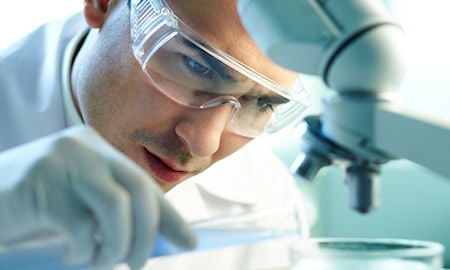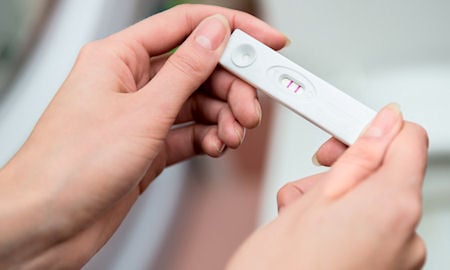
Micromanipulation
Advances in microscopic equipment and knowledge about eggs, sperm and embryos have lead to the development of new techniques in ART. Micromanipulation refers to the microscopic treatment of individual eggs, sperm, or embryos in an effort to improve fertilization and/or pregnancy rates. These techniques require specialized equipment and personnel. Currently, the most common micromanipulation techniques used are intracytoplasmic sperm injection (ICSI), which is used to assist fertilization in cases of severe male factor infertility, and assisted hatching, which is used in an effort to facilitate implantation of the embryos. Each clinic may have different instructions for patients using these techniques that should be followed to help maximize success.
Intracytoplasmic Sperm Injection
The ICSI technique has been developed to treat cases of severe male factor infertility. The ICSI technique attempts to achieve fertilization by the injection of a single sperm into the cytoplasm (interior) of the egg. Mature eggs are freed of surrounding cells by a combination of enzyme treatment and microdissection. Using special micromanipulation equipment (joystick-controlled robotics), the eggs are individually injected with a single sperm. Injected eggs are returned to the laboratory incubator and are treated as in conventional IVF-ET.
The benefit of ICSI is that it provides a way to treat extreme cases of male factor infertility which otherwise would remain untreatable. Experience shows that fertilization in vitro requires a minimum number of motile, normal-shaped sperm. The chance for fertilization in vitro becomes very low when this minimum number of sperm is not available. Theoretically, only a few sperm are necessary to perform ICSI. The alternatives to ICSI for treatment of severe male factor infertility are limited. One option is donor sperm. Use of donor sperm normalizes the success of conventional IVF-ET in couples with severe male factor infertility. In cases where male factor is the only diagnosis, pregnancies with donor sperm can be achieved through timed insemination, a treatment far less expensive and complicated than IVF-ET.
The potential consequences of injecting a normal appearing sperm, which is in fact genetically abnormal, include the development of a genetically abnormal embryo. Previous experience suggests that most abnormal conceptions do not implant or develop in the uterus. The incidence of congenital abnormalities (birth defects) following ICSI appears to be no higher than that of the general ART population. This observation is based on the experience of several thousand babies born worldwide following ICSI. There has been some evidence that ICSI may increase the probability of abnormal sex chromosomes or imprinting disorders. Larger studies though do not support these conclusions. However, this issue is an area of ongoing investigation and it must be recognized that long term risks of the procedure (for example, regarding the child’s fertility) are unknown. Recent evidence suggests that some forms of severe male factor infertility are genetic and may be passed on to male offspring through the ICSI procedure. In addition, within the normal human population, a certain percentage (approximately 4%) of children are born with physical or mental defects (congenital abnormalities) and the occurrence of such defects is beyond the control of physicians.
Assisted Hatching
Embryos are often transferred to the uterus three to six days after retrieval. Sometimes assisted hatching is used on day 3 embryos, which may consist of six to eight cells. After transfer of a day 3 embryo, the embryo must continue to develop to the blastocyst stage (a hollow ball of about 100 cells) before implantation can occur. This development takes several days. Immediately before implantation, the blastocyst must "'hatch" from the zona coating which originally enveloped the egg. To assist the hatching process, a hole is made into the sac (zona pellucida) that surrounds the developing embryos just prior to embryo transfer. This involves dissolving part of the zona coating with an acid solution or cutting it with a fine needle or laser. Trained personnel, using specialized micromanipulation tools, must perform this under the microscope. There is a small risk of damage to the embryos from the procedure. Fragment removal may occur at this time.
PGD/PGS PGD (Preimplantation Genetic Diagnosis)
Preimplantation Genetic Diagnosis (PGD) and Preimplantation Genetic Screening (PGS) are two techniques that can be used during in vitro fertilization (IVF) procedures to test embryos for genetic disorders prior to their transfer to the uterus. PGD and PGS make it possible for couples or individuals with serious inherited disorders to decrease the risk of having a child who is affected by the same problem. Both of these techniques involve the use of the micromanipulator to remove a cell from an embryo. This cell is then sent to a diagnostic lab to determine the embryo’s normalcy. Acceptable embryos can then be transferred into the patient, decreasing her odds of having an affected child. PGS has also been reported to increase the pregnancy rates of some women with chromosomal disorders that result in either lower implantation rates of embryos or higher miscarriage rates.
Freezing of Embryos and Frozen Embryo Transfer
Embryo freezing is an important part of successful ART programs. Freezing affords patients several advantages. Couples can freeze embryos in excess of the ones that are transferred during an IVF cycle. These embryos provide a second or even third opportunity for pregnancy without undergoing another ovarian stimulation and retrieval. Freezing can also increase the safety of an IVF cycle and help decrease the probability of multiples, as fewer embryos can be transferred in the fresh cycle when frozen embryos can be relied upon for subsequent pregnancy attempts.
Embryos that meet developmental criteria for appearance and rate of growth can be frozen at any of several stages of development. The most common method of freezing is called slow cooling. With this method embryos are placed into special freezing solutions, and using a computer, the temperature of the embryos is slowly decreased. Frozen embryos are then stored in liquid nitrogen (at -196°C or approximately -400°F), or sometimes, in liquid nitrogen vapor.
Another technique for freezing embryos is called vitrification. In this ultrarapid freezing method, embryos are placed into special solutions and then placed immediately into liquid nitrogen. Embryos are stored as for slow cooling. The method used to freeze embryos dictates how the embryos must be warmed or thawed. Not all embryos survive the freezing/thawing procedure and sometimes an embryo cannot be found after freezing.
Embryos can be transferred into patients whose cycle has been synchronized with that of the stage of the frozen embryo. This is similar to the method used for recipients of donor eggs where a GnRH agonist, estrogen and progesterone are used to synchronize the cycle. Alternatively, embryos can be transferred during a “natural” cycle. Embryos can be stored indefinitely in liquid nitrogen without a loss of viability.
Donor Eggs
One of the most important factors in predicting the success of IVF-ET is the age of the female partner. For patients under 30, success rates of 30-50 percent per egg retrieval can legitimately be expected; for patients over 40, realistic success rates are only 5 percent to at most 20 percent. Eggs from younger women possess greater fertility potential, and this potential is utilized in donor egg treatment. In this situation, eggs from another woman (the donor) are fertilized with the patient’s (the recipient) husband’s sperm, and the resultant embryos are placed in the recipient’s uterus. Follicles are stimulated and eggs are retrieved from the donor using routine IVF-ET techniques. The donor may be known to and recruited by the recipient (non-anonymous or known donation), or instead may be unknown to the recipient, having been recruited by a second party (anonymous donation). Anonymous egg donation usually occurs when a young, fertile woman donates her eggs to a recipient(s) during a particular cycle. The egg donor is usually reimbursed for her time and effort. Pregnancy rates using young donors are high, comparable to those achieved in women of similar age using their own eggs.
Candidates for Donor Egg
There are four main indications for treatment using donor eggs: 1) Ovarian failure. This can be due to a wide variety of different causes, including radiation, chemotherapy, surgical removal of the ovaries and a variety of disease states which cause or are associated with ovarian failure; 2) Women who carry a serious genetic disease who wish to diminish the chance that the disease will be passed on to their offspring; 3) Women whose age is sufficiently advanced so that their fertility potential is impaired significantly; and 4) Women who have had poor quality embryos during prior IVF cycles.
Laboratory Testing, Genetic Screening, and Psychological Assessment
A short time before initiating a treatment cycle, the egg donor undergoes a very thorough battery of tests for sexually transmitted diseases. Donors are screened for sexually transmitted diseases to minimize the chances that such a disease will be passed from the donor to the recipient (and possible fetus) by the egg donation process. Despite these thorough precautions, a very small risk of transmission of disease from donor to recipient remains. All donors must meet strict donor criteria as determined by the FDA. This includes proscribed tests for diseases, disease screening through a questionnaire, and a physical exam.
Donors have a very thorough evaluation of their medical, psychological and family history. The donor is required to fill out a multi-page form detailing her family history. The IVF personnel review this form and other aspects of the donor’s genetic and medical history prior to acceptance of the donor into the program. Even with this intensive screening, there remains a small risk that a baby resulting from the egg donation process will suffer from a genetic disease. Overall, a baby conceived through egg donation will have the same risk of birth defect, trivial or catastrophic, genetic or non-genetic, as the human population as a whole, namely 3-5 percent. The donor and recipient may also receive psychological screening and counseling with a mental health professional to assess their motivations and acceptance of the process. This evaluation serves as an additional opportunity to learn about family and medical history.
Matching Donor and Recipient
One requirement of most anonymous donation programs is that anonymity be maintained. In order to accomplish this, the amount of information given a recipient about the donor is limited. This information usually includes the donor’s height and weight, hair color, eye color, race, blood type, age, duration of formal education and family medical history.
Treatment of the Egg Donor
In general, stimulation of the egg donor’s cycle is similar to that of a woman using her own eggs for in vitro fertilization-embryo transfer. Birth control pills are often used in the cycle preceding stimulation. Late in the cycle which precedes ovarian stimulation, the donor may be started on daily treatment with one of two drugs, Lupron® or Synarel®, usually the former. Daily injections of Lupron® will continue until oocyte retrieval. Alternatively, a GnRH antagonist such as Antagon® or Cetrotide® may be given after stimulation has begun to prevent ovulation. After the donor’s period has started, daily intramuscular injections of a pharmaceutical gonadotropin preparation, such as FSH and HMG, will be added to the daily Lupron® injections. Various brands of these hormones can be used. Generally, the donor will receive daily gonadotropin injections for a total of seven to 12 days. During the time that the donor is receiving the gonadotropin injections, she will have frequent vaginal ultrasound examinations and blood drawing for determination of estradiol (E2) level. When ultrasound and blood testing indicate that development of the follicles (follicles are the ovarian structures that contain the eggs) is optimum, the donor receives an injection of a different pharmaceutical medication called human chorionic gonadotropin (hCG). Two days (35-36 hours) after hCG injection, egg retrieval is performed. A sperm specimen is collected from the recipient’s partner on the day of the retrieval because the eggs are inseminated on this day. Transfer of fertilized eggs (embryos) to the recipient’s uterus is generally performed three to five days after egg retrieval.
Treatment Regimen for Recipients
The recipient’s cycle must be manipulated to synchronize her with the donor. A combination of two or three hormonal medications is used to modify the recipient’s cycle.
Recipients who have regular menstrual cycles and bleeding on their own will be given a medication which suppresses their own cycle. Sometimes oral contraceptives will be used. A short time after her period starts, the recipient will begin taking estrogen. Estrogen comes in several forms including patches, oral tablets and vaginal suppositories. The recipient will take estrogen while waiting for the donor’s cycle to come into synchrony with hers. When the donor’s cycle has “caught up” with the recipient’s, a simulated (artificial) menstrual cycle will be created in the recipient with the hormonal medications. To do this, the recipient takes an increased dose of estrogen as the donor stimulates. Sometimes blood tests and/or ultrasounds are done to ensure an appropriate response. On the morning after egg retrieval, progesterone treatment is begun. Daily progesterone can be in the form of an intramuscular injection or a suppository. The recipient will continue taking estrogen and progesterone at least until the day her pregnancy test is performed. Fresh embryo transfer is usually done 3-5 days after egg retrieval. A sensitive blood pregnancy test will be performed 10 to 14 days after embryo transfer. If the recipient is pregnant, estrogen and progesterone treatment may be continued through about the 12th week of pregnancy.
Gestational Carriers
In some instances, a couple may require the assistance of a gestational carrier to achieve a successful pregnancy. Gestational carriers differ from true surrogates in that they have no genetic link to the baby they will carry. The commissioning couple (future parents) will provide the embryo through IVF. As with egg donation, the best statistics occur when the embryos are transferred during a fresh cycle, requiring that the woman and her gestational surrogate be synchronized as with egg donation. Some states have laws that address surrogacy and you should seek legal advice about this. For example, Florida law requires that a woman have a medical indication for a gestational carrier to be utilized. The most common indications include a woman who has congenital absence of the uterus, prior surgery to remove her uterus, severe scarring of the uterine cavity, or a medical history that precludes pregnancy. In addition to meeting the medical requirement, a separate legal contract is required before treatment can begin. In Texas, in order for the carrier not to be identified as the legal mother, the surrogacy arrangement must be reviewed and approved by a judge before treatment begins. Programs may or may not have ready access to a group of potential gestational carriers. Generally, however, they can provide resources for investigation. Once a gestational carrier has been identified and the medical, psychological, and legal prerequisites completed, treatment can proceed. Because gestational carriers will receive an embryo from a donor couple, the donors (future parents) must be treated as egg and sperm donors and follow all of the requirements of the FDA for screening and testing as indicated by the FDA.

